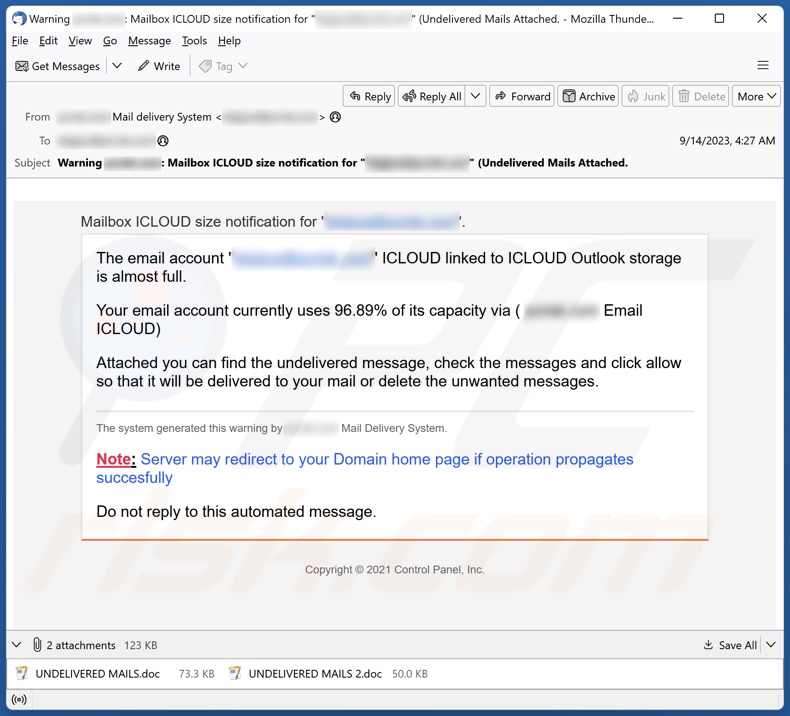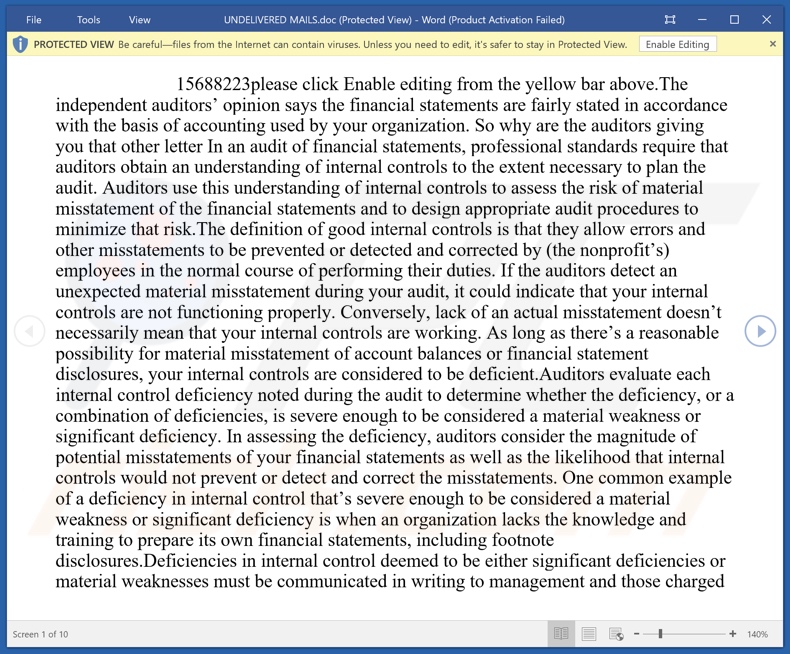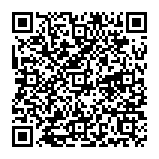Avoid infecting your device through fake "ICLOUD Outlook Storage" emails
![]() Written by Tomas Meskauskas on
Written by Tomas Meskauskas on
What kind of email is "ICLOUD Outlook Storage"?
Our inspection of the "ICLOUD Outlook Storage" email revealed that it is malicious spam (malspam). It falsely claims that the recipient's iCloud-linked Outlook account is almost full – hence, multiple incoming messages failed delivery.
This fake notification states that the undelivered emails can be found in the attachments which, in fact, are malicious documents designed to infect systems with the Agent Tesla RAT (Remote Access Trojan).

"ICLOUD Outlook Storage" email virus overview
The spam email informs the recipient that their iCloud-linked Outlook account has reached 96.80% of its storage capacity. Due to this, incoming messages have failed to reach the inbox. They can be reviewed and discarded or sent to the mailbox through the attached file.
It must be stressed that these claims are false, and this mail is in no way associated with either Apple iCloud or Microsoft Outlook.
This scam email has two attachments, titled "UNDELIVERED MAILS.doc" and "UNDELIVERED MAILS 2.doc". Their appearance is identical, and both are intended to infiltrate the Agent Tesla RAT into devices. The malicious Word documents encourage users to enable editing, as that is how these formats infect systems – by executing malicious macro commands. These specific documents contain extensive text regarding audits and finances.
As previously mentioned, the attached files proliferate malware; more information on the RAT in question can be found in our article on Agent Tesla.
To summarize, victims of emails like "ICLOUD Outlook Storage" can experience system infections, severe privacy issues, financial losses, and even identity theft.
If you believe that your device has already been infected, we strongly recommend running a complete system scan with an anti-virus and removing all detected threats without delay.
| Name | "ICLOUD Outlook Storage" malspam |
| Threat Type | Malspam, spam, trojan, password-stealing virus, banking malware, spyware. |
| Fake Claim | Account storage is full and the undelivered emails can be found in the attachments. |
| Disguise | Apple iCloud, Microsoft Outlook |
| Attachment(s) | UNDELIVERED MAILS.doc, UNDELIVERED MAILS 2.doc (filenames may vary) |
| Detection Names (UNDELIVERED MAILS.doc) | Avast (Other:Malware-gen [Trj]), Combo Cleaner (Trojan.GenericKD.69274154), DrWeb (Exploit.CVE-2018-0798.4), Kaspersky (HEUR:Exploit.MSOffice.CVE-2018-0802.ge), McAfee (RTFObfustream.c!D76C8672638B), Full List Of Detections (VirusTotal) |
| Detection Names (UNDELIVERED MAILS 2.doc) | Avast (Other:Malware-gen [Trj]), Combo Cleaner (Trojan.GenericKD.69274150), DrWeb (Exploit.CVE-2018-0798.4), Fortinet (MSOffice/CVE_2018_0798.BOR!exploit), Kaspersky (HEUR:Exploit.MSOffice.CVE-2018-0802.g), Full List Of Detections (VirusTotal) |
| Payload | Agent Tesla |
| Symptoms | Trojans are designed to stealthily infiltrate the victim's computer and remain silent, and thus no particular symptoms are clearly visible on an infected machine. |
| Distribution methods | Infected email attachments, malicious online advertisements, social engineering, software 'cracks'. |
| Damage | Stolen passwords and banking information, identity theft, the victim's computer added to a botnet. |
| Malware Removal (Windows) | To eliminate possible malware infections, scan your computer with legitimate antivirus software. Our security researchers recommend using Combo Cleaner. |
Malspam campaign examples
"C&K STEEL COMPANY", "Crimson International email virus", "Updated Terms of Use", and "Requested Documents" are just some examples of malware-spreading emails. This mail is used to proliferate various malicious programs, e.g., trojans, ransomware, cryptocurrency miners, etc.
Spam emails are also used to facilitate phishing and other scams. These emails/messages may be basic or elaborately disguised as mail from legitimate companies, institutions, organizations, service providers, authorities, and other entities.
Due to how widespread spam mail is and how well-made it can be – we advise exercising caution with incoming emails, PMs/DMs, SMSes, and other messages.
How do spam campaigns infect computers?
Spam campaigns are often used to spread malware. Malicious files can be attached to or linked inside these emails/messages. The files can be documents (Microsoft Office, Microsoft OneNote, PDF, etc.), archives (ZIP, RAR, etc.), executables (.exe, .run, etc.), JavaScript, and so forth.
Once an infectious file is opened – the infection chain is triggered. However, some formats may need additional actions – and this is the case with the "ICLOUD Outlook Storage" email attachments. Microsoft Office documents require users to enable macro commands (i.e., editing/content) to jumpstart malware download/installation chains.
How to avoid installation of malware?
We recommend being careful with incoming emails and other messages. Attachments or links found in suspect/irrelevant mail must not be opened, as they can be malicious. It is crucial to use Microsoft Office versions released after 2010 since they have the "Protected View" mode that prevents automatic macro execution.
It must be mentioned that malware is not distributed only via spam mail. Hence, all downloads must be performed from official and verified sources. Another recommendation is to activate and update software by using legitimate functions/tools, as illegal activation tools ("cracks") and third-party updaters may contain malware.
We also advise caution when browsing since fraudulent and dangerous online content typically appears genuine and harmless.
It is essential for device/user safety to have a reputable anti-virus installed and kept up-to-date. Security programs must be used to run regular system scans and to remove threats and issues. If you've already opened malicious attachments, we recommend running a scan with Combo Cleaner Antivirus for Windows to automatically eliminate infiltrated malware.
Text presented in the "ICLOUD Outlook Storage" spam email letter:
Subject: Warning ********: Mailbox ICLOUD size notification for "********" (Undelivered Mails Attached.
Mailbox ICLOUD size notification for "********".
The email account "********" ICLOUD linked to ICLOUD Outlook storage is almost full.
Your email account currently uses 96.89% of its capacity via ( ******** Email ICLOUD)
Attached you can find the undelivered message, check the messages and click allow so that it will be delivered to your mail or delete the unwanted messages.
The system generated this warning by ******** Mail Delivery System.
Note: Server may redirect to your Domain home page if operation propagates succesfully
Do not reply to this automated message.
Copyright © 2021 Control Panel, Inc.
Screenshot of a malicious attachment distributed via this spam campaign ("UNDELIVERED MAILS.doc"):

Instant automatic malware removal:
Manual threat removal might be a lengthy and complicated process that requires advanced IT skills. Combo Cleaner is a professional automatic malware removal tool that is recommended to get rid of malware. Download it by clicking the button below:
▼ DOWNLOAD Combo Cleaner
By downloading any software listed on this website you agree to our Privacy Policy and Terms of Use. To use full-featured product, you have to purchase a license for Combo Cleaner. 7 days free trial available. Combo Cleaner is owned and operated by Rcs Lt, the parent company of PCRisk.com read more.
Quick menu:
- What is "ICLOUD Outlook Storage" malspam?
- Types of malicious emails.
- How to spot a malicious email?
- What to do if you fell for an email scam?
Types of malicious emails:
![]() Phishing Emails
Phishing Emails
Most commonly, cybercriminals use deceptive emails to trick Internet users into giving away their sensitive private information, for example, login information for various online services, email accounts, or online banking information.
Such attacks are called phishing. In a phishing attack, cybercriminals usually send an email message with some popular service logo (for example, Microsoft, DHL, Amazon, Netflix), create urgency (wrong shipping address, expired password, etc.), and place a link which they hope their potential victims will click on.
After clicking the link presented in such email message, victims are redirected to a fake website that looks identical or extremely similar to the original one. Victims are then asked to enter their password, credit card details, or some other information that gets stolen by cybercriminals.
![]() Emails with Malicious Attachments
Emails with Malicious Attachments
Another popular attack vector is email spam with malicious attachments that infect users' computers with malware. Malicious attachments usually carry trojans that are capable of stealing passwords, banking information, and other sensitive information.
In such attacks, cybercriminals' main goal is to trick their potential victims into opening an infected email attachment. To achieve this goal, email messages usually talk about recently received invoices, faxes, or voice messages.
If a potential victim falls for the lure and opens the attachment, their computers get infected, and cybercriminals can collect a lot of sensitive information.
While it's a more complicated method to steal personal information (spam filters and antivirus programs usually detect such attempts), if successful, cybercriminals can get a much wider array of data and can collect information for a long period of time.
![]() Sextortion Emails
Sextortion Emails
This is a type of phishing. In this case, users receive an email claiming that a cybercriminal could access the webcam of the potential victim and has a video recording of one's masturbation.
To get rid of the video, victims are asked to pay a ransom (usually using Bitcoin or another cryptocurrency). Nevertheless, all of these claims are false - users who receive such emails should ignore and delete them.
How to spot a malicious email?
While cyber criminals try to make their lure emails look trustworthy, here are some things that you should look for when trying to spot a phishing email:
- Check the sender's ("from") email address: Hover your mouse over the "from" address and check if it's legitimate. For example, if you received an email from Microsoft, be sure to check if the email address is @microsoft.com and not something suspicious like @m1crosoft.com, @microsfot.com, @account-security-noreply.com, etc.
- Check for generic greetings: If the greeting in the email is "Dear user", "Dear @youremail.com", "Dear valued customer", this should raise suspiciousness. Most commonly, companies call you by your name. Lack of this information could signal a phishing attempt.
- Check the links in the email: Hover your mouse over the link presented in the email, if the link that appears seems suspicious, don't click it. For example, if you received an email from Microsoft and the link in the email shows that it will go to firebasestorage.googleapis.com/v0... you shouldn't trust it. It's best not to click any links in the emails but to visit the company website that sent you the email in the first place.
- Don't blindly trust email attachments: Most commonly, legitimate companies will ask you to log in to their website and to view any documents there; if you received an email with an attachment, it's a good idea to scan it with an antivirus application. Infected email attachments are a common attack vector used by cybercriminals.
To minimise the risk of opening phishing and malicious emails we recommend using Combo Cleaner Antivirus for Windows.
Example of a spam email:

What to do if you fell for an email scam?
- If you clicked on a link in a phishing email and entered your password - be sure to change your password as soon as possible. Usually, cybercriminals collect stolen credentials and then sell them to other groups that use them for malicious purposes. If you change your password in a timely manner, there's a chance that criminals won't have enough time to do any damage.
- If you entered your credit card information - contact your bank as soon as possible and explain the situation. There's a good chance that you will need to cancel your compromised credit card and get a new one.
- If you see any signs of identity theft - you should immediately contact the Federal Trade Commission. This institution will collect information about your situation and create a personal recovery plan.
- If you opened a malicious attachment - your computer is probably infected, you should scan it with a reputable antivirus application. For this purpose, we recommend using Combo Cleaner Antivirus for Windows.
- Help other Internet users - report phishing emails to Anti-Phishing Working Group, FBI’s Internet Crime Complaint Center, National Fraud Information Center and U.S. Department of Justice.
Frequently Asked Questions (FAQ)
Why did I receive this email?
Cyber criminals distribute spam mail in large-scale campaigns – therefore, thousands of users receive identical emails/messages.
I have provided my personal information when tricked by a spam email, what should I do?
If you have disclosed your log-in credentials – immediately change the passwords of all possibly exposed accounts and inform their official support. And if the provided information was of a different personal nature (e.g., ID card details, credit card numbers, etc.) – contact relevant authorities without delay.
I have read a spam email but didn't open the attachment, is my computer infected?
Devices are infected when malicious attachments or links are opened; just reading an email will not initiate system infection chains.
I have downloaded and opened a file attached to a spam email, is my computer infected?
If the opened file was an executable (.exe, .run, etc.) – most likely, yes – your system was infected. However, you might have avoided an infection if it was a document (.doc, .xls, .one, .pdf, etc.). These formats may need extra actions to trigger malware download/installation processes (e.g., enabling macro commands, clicking embedded files/links, etc.).
Will Combo Cleaner remove malware infections present in email attachments?
Yes, Combo Cleaner is capable of detecting and removing almost all known malware infections. It must be stressed that performing a complete system scan is paramount since sophisticated malicious programs typically hide deep within systems.


▼ Show Discussion